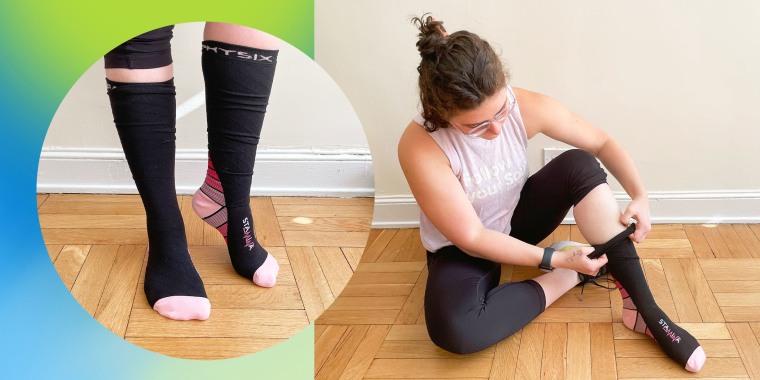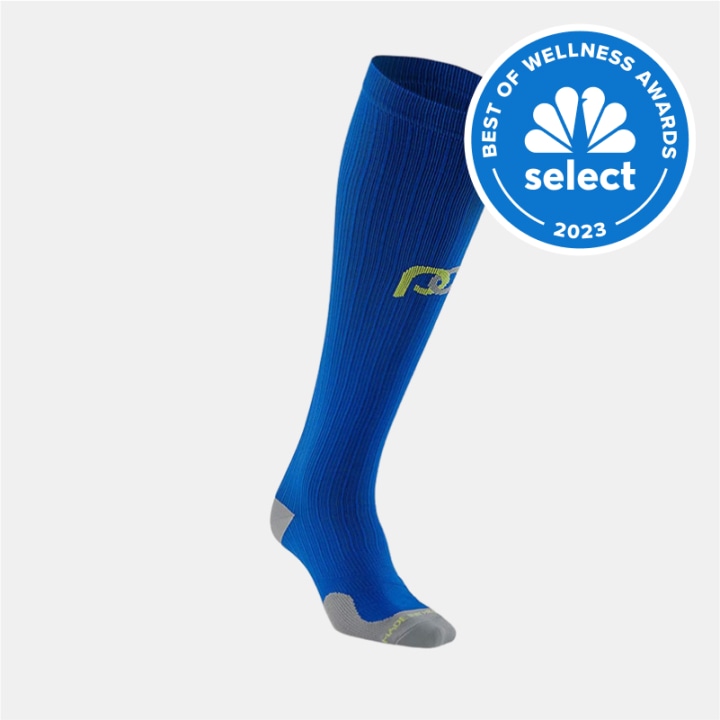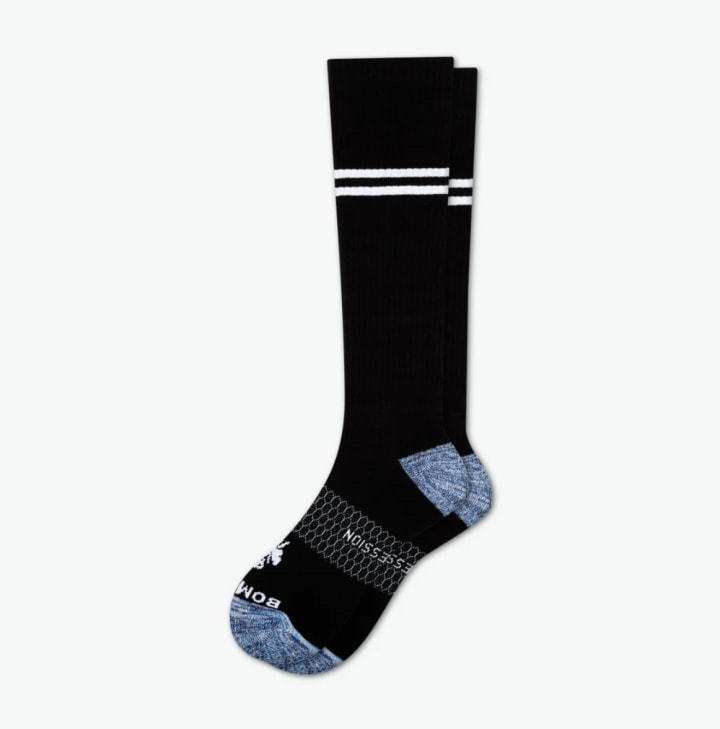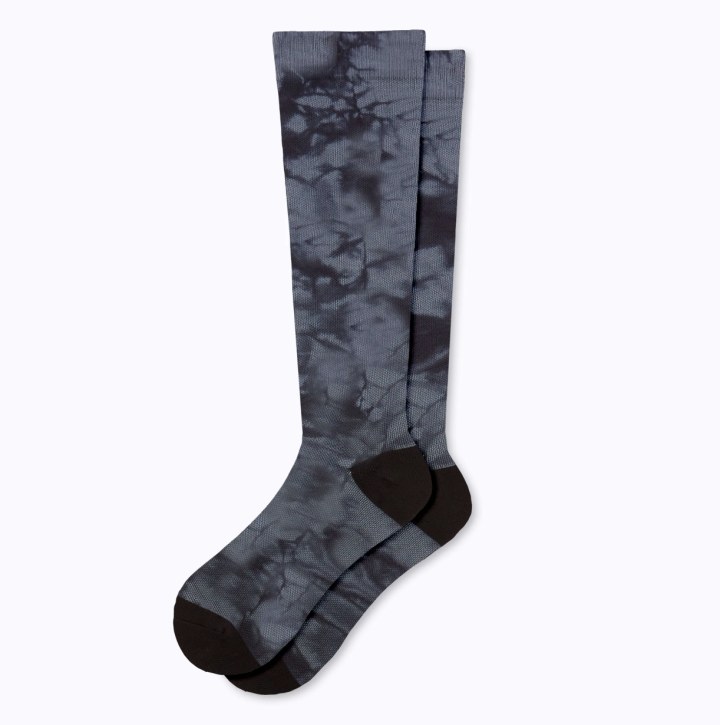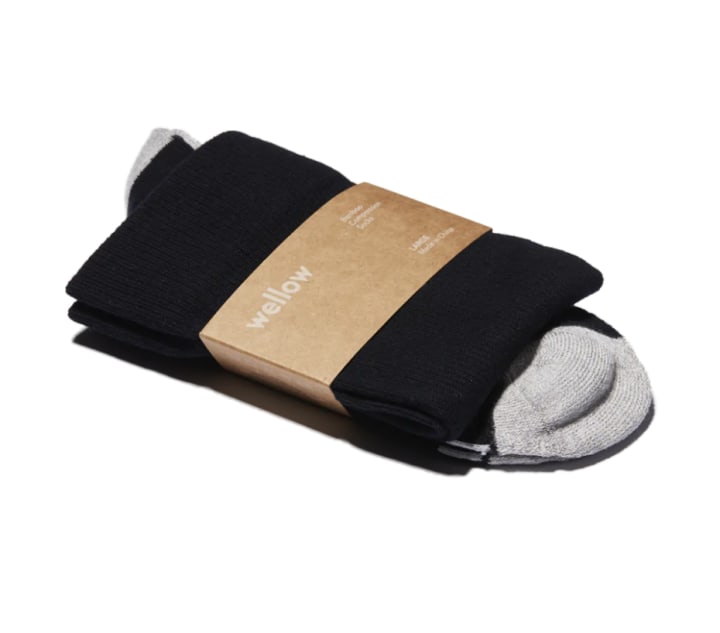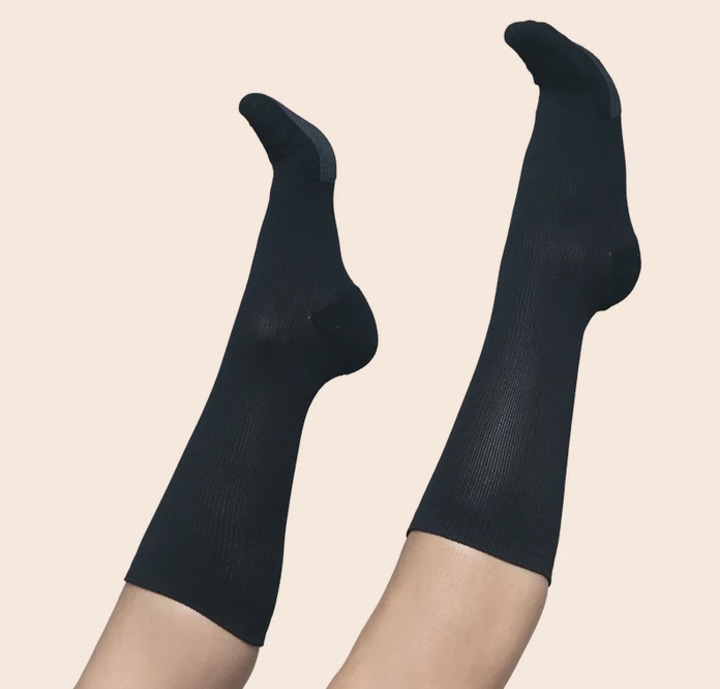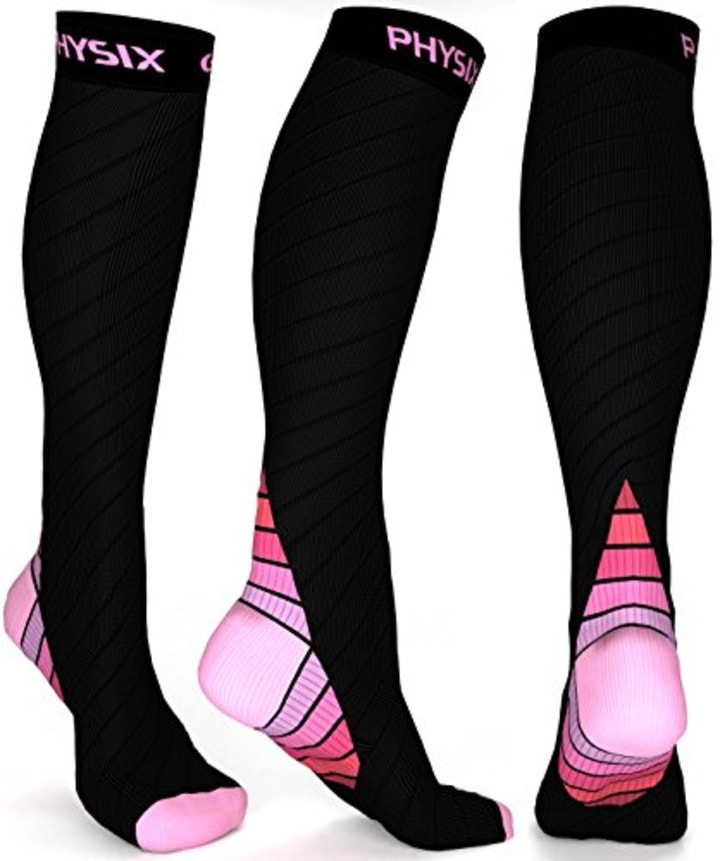If you’ve ever been on a long flight or worked a job where you’re constantly on your feet, your legs may have felt tired, achy and swollen afterwards. Fluid begins to build up in your legs after sitting or standing for a while — when you don’t get up and walk around every 60 to 90 minutes, it can create an uncomfortable feeling, said Dr. Khurram Khan, a clinical associate professor at Temple University's School of Podiatric Medicine. Compression socks, which work to promote better circulation by gently applying pressure to your legs, feet and ankles, may be able to help.
“From a medical standpoint, the main action of compression socks is to help your veins work better,” said Dr. Tamara Horwich, a professor at UCLA and the medical director for the university’s Cardiac Rehabilitation Program. “They help push blood in your legs back to your heart more easily.”
SKIP AHEAD Compression socks to shop | Who should wear compression socks?
If you’re thinking about investing in a pair of compression socks, it’s helpful to have some background knowledge, like what different pressure levels mean and what type works best for different needs. We spoke to experts about how to shop for compression socks and who may want to consider wearing them. We also used expert guidance to recommend a handful of compression socks you can purchase.
How to shop for compression socks
There are three main factors to keep in mind while shopping for compression socks: type, pressure level and style. These factors dictate the socks’ fit and how much pressure they apply to your legs, feet and ankles. Keep in mind that each person has different preferences, so it may take trying a few different pairs to decide which is best for you.
Type
There are two types of compression socks: graduated and anti-embolism. Both are usually designed with knitted, snug, stretchy fabric, Horwich said, but some are also made with thicker materials like wool, which can keep your legs warmer during the colder months.
- Graduated compression socks are used by the majority of wearers. Khan said they’re tighter around the foot and ankle and gradually get looser higher up the leg (hence the name). Graduated compression socks support the lower legs the most — that’s where fluid builds up when you’re sitting or standing for long periods of time.
- Anti-embolism compression socks are specifically designed to prevent blood clots by applying a uniform amount of pressure, Khan said. Experts said you should consult with a medical professional before using anti-embolism compression socks — they’re mostly used by those who are bedridden before or after surgery, or for other medical reasons.
Pressure level
The amount of pressure that compression socks apply to the legs is measured in millimeters of mercury (mmHg), Horwich explained. Khan shared the following guidance about different pressure levels:
- 8 to 15 mmHg is a mild amount of pressure and is best for everyday wear.
- 15 to 20 mmHg is a moderate amount of pressure. Khan recommended this pressure range for people who may be standing or sitting all day, like if you’re a nurse who's constantly on your feet or if you work a 9-to-5 desk job.
- 20 to 30 mmHg is a firm amount of pressure. Most people who opt for this higher level of pressure get a direct recommendation to do so from a healthcare or sports medicine professional.
- 30 to 40 mmHg is an extra firm amount of pressure and should only be worn if prescribed by a healthcare professional.
Style
The most common compression sock style is closed-toe knee-highs, but you may also see thigh-high and open-toed options, Horwich said. Some compression socks don’t cover your foot at all and resemble leg warmers more than socks. Choosing a style depends on where you want to feel pressure. For example, if you notice the most discomfort in your ankles and calves and your feet are generally fine, open-toed compression socks may be a good option.
Compression socks to shop
We used expert guidance to recommend the compression socks below. We included each sock’s pressure level and only recommended graduated compression socks since experts told us they’re useful for the majority of wearers.
Pro Compression Marathon Socks
- Pressure level: 20-30 mmHg
The Pro Compression Marathon Socks are a Select Wellness Award winner. They’re made from nylon and lycra spandex, which are sweat-wicking materials, according to the brand. I typically wear these compression socks after a workout for over an hour to help my muscles relax. They’re comfortable to wear with and without shoes, in my experience, and come in three sizes: extra small, small to medium and large to extra large.
Bombas Everyday Compression Socks
- Pressure level: 15-20 mmHg
Bombas’ knee-high cotton compression socks are designed with extra durable yarn, which the brand says makes them more resistant to constant wear. The socks have a y-stitched heel to create a cup around that part of your foot for added support, according to Bombas. They’re available in small, medium and large sizes, and you can purchase them in white, black or grey.
Comrad Knee-High Compression Socks
- Pressure level: 15-20 mmHg
Comrad offers compression socks in a variety of colors and patterns with light, medium and firm pressure levels. These medium pressure knee-high compression socks are made from a thin nylon material that the brand says is breathable and moisture-wicking. The socks are also designed with silver antimicrobial ions to eliminate odors, according to Comrad. There’s cushioning in the heel and toe, and the socks are available in small, medium, medium wide, large and large wide sizes.
Wellow Compression Socks
- Pressure level: 18-25 mmHg
Wellow’s knee-high compression socks are constructed from a bamboo fabric that the brand says is antimicrobial and moisture-wicking. You can purchase the compression socks in 10 solid colors from black to bright blue, as well as in Twist and Dot patterns. They’re available in small, medium, large and extra large sizes.
Apolla The Infinite Mid-Calf Recovery Compression Socks
- Pressure level: 20-30 mmHg
If you prefer shorter socks, Apolla sells compression socks in mid-calf, crew, no-show and open-toed styles. The mid-calf socks are made from Repreve, a recycled fiber material that the brand says is antimicrobial and moisture-wicking. Apolla, which was featured on Shark Tank, designed its compression socks with padding in the heel and at the ball of the foot for added comfort. You can purchase the socks in extra small, medium, large and extra large sizes, and they come in black or grey.
Physix Gear Sport Compression Socks
- Pressure level: 20 to 30 mmHg
When I started running longer distances, my legs always felt like Jell-O for a day or two afterwards. My chiropractor suggested I purchase these firm compression socks, and my legs feel less heavy when I wear them. The compression socks are made from nylon and spandex materials to help repel moisture, according to the brand. You can purchase the socks in small/medium, large/extra large and extra extra large sizes. They’re available in colors like pink, red, orange and beige.
When to wear — and when not to wear — compression socks
Generally speaking, anyone who spends an extended period of time standing or sitting can benefit from wearing compression socks. But there are some situations where compression can especially come in handy, Horwich said:
- If you’re taking a long flight (over 4 hours)
- If you experience dizziness due to low blood pressure (which is one of the reasons why I started wearing compression socks)
- After a long run — I usually put on my compression socks after I run to help reduce leg soreness and stiffness
Compression socks can also help prevent some spider and varicose vein formation if worn over a longer period of time, experts told us. Many people find them helpful during pregnancy, too.
Keep in mind that compression socks should not be worn overnight, Khan said. They’re designed to be worn during the day because when you lay down at night, swelling in your legs, ankles and feet naturally decreases.
When to consult a doctor about wearing compression socks
Whether or not you need to consult a doctor before wearing compression socks depends on your personal health concerns, Khan said. But it's always a good idea to talk to a medical professional before starting new types of treatments, experts told us.
Khan noted that young adults with no health concerns can wear most types of compression socks without consulting a doctor. But older adults or anyone who experiences chronic leg swelling “should consult a doctor to make sure they know the cause of the swelling and are on the right treatment before starting to wear compression socks,” Horwich said.
Catch up on Select's in-depth coverage of personal finance, tech and tools, wellness and more, and follow us on Facebook, Instagram and Twitter to stay up to date.
